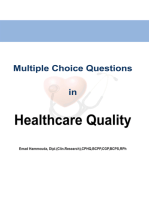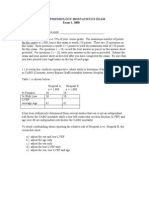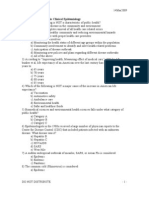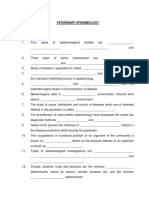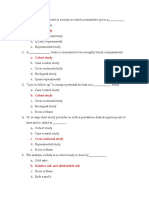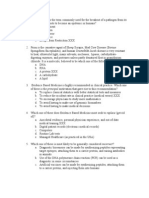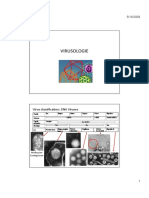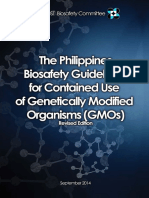Epidemiology MCQ 2
Epidemiology MCQ 2
Uploaded by
Martinc23Copyright:
Available Formats
Epidemiology MCQ 2
Epidemiology MCQ 2
Uploaded by
Martinc23Original Title
Copyright
Available Formats
Share this document
Did you find this document useful?
Is this content inappropriate?
Copyright:
Available Formats
Epidemiology MCQ 2
Epidemiology MCQ 2
Uploaded by
Martinc23Copyright:
Available Formats
An investigator evaluated 1000 persons in a community suspected to be suffering from STD and later confirmed by a serological test.
The results were: Present 120 Q1. Q2. Q3. Q4. 280 STD Absent 180 420
+ S. Test
The positive predictive value for the test is: In the above results, the specificity of the test is: In the above results, the sensitivity of the test is: In the above results the accuracy of the test is:
Q. Sensitivity of a screening test is: a. the ability to correctly identify individuals who have a specific disease b. the ability to correctly identify individuals who do not have a specific disease c. the ability to be as reliable as possible. d. The ability to be as precise as possible. Q. The negative predictive value of a screening test is the proportion of: a. true positives among all positives b. true negatives among all negatives c. false positives among all positives d. false negatives among all negatives ABSOLUTE RISK Done by comparing occurrences to calculate the risk that a health effect will r esult from an exposure. Comparisons can be done by: 1. absolute and 2. relative comparisons; These measures describe the strength of an association between exposure and outc ome.
In a prospective study to elicit the relationship between oral contraceptive use and the subsequent risk of developing endometrial cancer, a cohort of 1000 wom en were followed for 5 years. The results were as follows: ENDOMETRIAL CANCER Present Absent + 245 75 O.C.P. USE 50 630 What is the a) Absolute risk b) Relative risk and c) Attributable risk percent o f endometrial cancer in the study? Summary of measure effects: DISEASE Present Absent + RISK _
1. Absolute Risk: with risk factor= A/(A+B) without risk factor= C/C+D 2. Attributable Risk= A/(A+B) - C/(C+D) 3. Attributable Risk Percent = (Attributable Risk / Absolute Risk) 4. Relative Risk = A/(A+B) C/(C+D) i. e. Absolute risk with risk factor Absolute risk without risk factor X 100
Absolute Risk: Absolute Risk: in OCP users = 0.76 in OCP non-users = 0.07 Absolute Risk allows us to separately calculate the incidences of a particular dis ease in both populations with a risk factor and without it, for making risk com parisons. Attributable Risk Attributable Risk = A/(A+B) - C/(C+D) = 0.77 0.07 = 0.70 Attributable Risk allows us to attribute differences in the incidences of a diseas e to a particular risk factor. Attributable Risk Percent Attributable Risk Percent = Attributable RiskX 100 Absolute Risk =(0.70/ 0.77) X 100 = 91% Attributable Risk is often expressed as Attributable Risk Percent where Attributa ble Risk is a percentage of the Absolute Risk (Incidence Rate among those expose d to the risk factor) and this percentage is most frequently used to justify the inception of risk prevention programs when attributable risk factor percentages are high. Odds Ratio The association of an exposure and a disease (relative risk) in a case-control s tudy is measured by calculating the odds ratio (OR), which is the ratio of the o dds of exposure among the cases to the odds of exposure among the controls. The odds ratio is given by: A/B C/D or AD / BC ASSOCIATION BETWEEN MEAT CONSUMPTION AND FOOD POISONING: Odds Ratio This indicates that the cases were 11.6 times more likely than the controls to h ave recently eaten meat. The odds ratio is very similar to the risk ratio, particularly if a disease is ra re. For the odds ratio to be a good approximation, the cases and controls must be re presentative of the general population with respect to exposure. However, because the incidence of disease is unknown, the absolute risk can not be calculated. Q. In a prospective study to find the relationship between HIV status and subseq uent risk of developing non-Hodgkins B-cell lymphoma, a cohort of 600 men were fo
llowed from 1981 to 1991. The results of follow-up study are presented in the t able. Find: a) Abs. Risk Non Hodgkins B cell Lymphoma b) Attr. Risk Present Absent c) RR + 75 25 HIV 50 450
Q: The prevalence of STD in a community was 10%. The sensitivity of a serolo gical test employed was 80% with a specificity of 90%. 1. What would be the Positive Predictive Rate of the serological test? A. Very high B. low C. About 50% D. Negligible 2. What would be the Accuracy of the serological test? A. Very high B. low C. About 50% D. Negligible Q. A new radiologic scanning test for the early detection of osteogenic sar coma was used to evaluate 500 patients. The results of the study were as follows : OSTEOGENIC SAR COMA Present Absent + 100 150 TEST 75 175 1Q. What is the negative predictive value of the test? 2Q. What is the specificity of the test? 3Q. What is the positive predictive value of the test? 4Q. What is the sensitivity of the test? 5Q. What is the accuracy of the test? A. 100/250 B. 75/250 C. 175/250 D. 100/175 E. 175/325 Q. The results of a follow up study to see the association of lung cancer to smoking are as follows: Lung cancer Present Absent + 225 75 Smoking 100 565. 1Q. The absolute risk for smokers in the study is? 2Q. The relative risk for smokers in the above study is? 3Q. The attributable risk for smoking in the above study is
An investigator evaluated 100 patients suffering from major depression as co nfirmed by the attending psychiatrist. The results were: Clinical depression Present Absent + 12 18 Test _ 28 42 1Q.The positive predictive value for the test is? 2Q. In the above results, the specificity of the test is? 3Q. In the above results, the sensitivity of the test is? A. 12/40 B. 18/60 C. 42/60 D. 12/30 E. 42/60.
You might also like
- 130 TOP Epidemiology Multiple Choice Questions and Answers - All Medical Questions and AnswersDocument12 pages130 TOP Epidemiology Multiple Choice Questions and Answers - All Medical Questions and AnswersFaiq Syukri Bin Saparudin83% (173)
- (MCQS) BiostatsDocument58 pages(MCQS) Biostatsvishal_life2791% (44)
- 100 Multiple-Choice Questions (MCQS) For Biostatistics - Clinical CornerDocument16 pages100 Multiple-Choice Questions (MCQS) For Biostatistics - Clinical Cornerilerioluwaibitoye100% (3)
- Self-Assessment Quiz: Introduction To Epidemiology Page 1-85Document75 pagesSelf-Assessment Quiz: Introduction To Epidemiology Page 1-85Coy Nuñez100% (9)
- Answer of Exercises-Measures of Disease FrequencyDocument7 pagesAnswer of Exercises-Measures of Disease Frequencysanjivdas83% (6)
- Multiple Choice Questions in Healthcare QualityFrom EverandMultiple Choice Questions in Healthcare QualityRating: 4 out of 5 stars4/5 (8)
- Biostatistics MCQDocument5 pagesBiostatistics MCQSajjadAhmad_QMC83% (76)
- Descriptive studies MCQs فراسDocument6 pagesDescriptive studies MCQs فراسHisokagen100% (5)
- Epidemiology QuestionsDocument7 pagesEpidemiology Questionsbravof86% (7)
- 2018 Biosatics MCQDocument33 pages2018 Biosatics MCQDesalegn Tesfaye100% (4)
- Biostatistics-I MCQS: Topic: Sample Descriptive StaticsDocument40 pagesBiostatistics-I MCQS: Topic: Sample Descriptive StaticsGhulam Mustafa100% (4)
- TEST YOURSELF: Multiple Choice 1 QuestionsDocument5 pagesTEST YOURSELF: Multiple Choice 1 Questionsanaphysioforyou50% (2)
- Session 3 With AnswrsDocument14 pagesSession 3 With AnswrsWafa Abdullah100% (2)
- Community Medicine MCQsDocument355 pagesCommunity Medicine MCQsKalpu Bala100% (10)
- Epidemiology MCQDocument122 pagesEpidemiology MCQሌናፍ ኡሉም60% (5)
- Epi Exam 2 Q&aDocument13 pagesEpi Exam 2 Q&aeman100% (1)
- Quiz Public HealthDocument26 pagesQuiz Public HealthMedShare89% (27)
- Question Bank EpidemiologyDocument32 pagesQuestion Bank EpidemiologyRamesh Beniwal90% (10)
- National TB Control Program Form 7 - Referral FormDocument1 pageNational TB Control Program Form 7 - Referral FormAre Pee EtcNo ratings yet
- MUST To KNOW in Immunology and SerologyDocument18 pagesMUST To KNOW in Immunology and SerologyRona Salando50% (2)
- What Is Antibiotic Resistance?Document3 pagesWhat Is Antibiotic Resistance?honnyzeNo ratings yet
- Of Malaria: It Only Takes One To Bite Catch MalariaDocument2 pagesOf Malaria: It Only Takes One To Bite Catch MalariaFides LandichoNo ratings yet
- Epidemiology MCQDocument9 pagesEpidemiology MCQPREM KUMAR100% (4)
- Introduction To Epidemiology and Public Health - AnswersDocument8 pagesIntroduction To Epidemiology and Public Health - Answersjackwisher hasting100% (2)
- Assignment 1 - YoungDocument15 pagesAssignment 1 - Youngejyoung928100% (2)
- 2006 MCQ ExamsDocument18 pages2006 MCQ ExamsTehreem Khan100% (1)
- Epidemiology MCQsDocument4 pagesEpidemiology MCQsChikezie Onwukwe100% (2)
- Epidemiology MCQsDocument4 pagesEpidemiology MCQsyooshlo76% (33)
- Epidemmiology MCQs With Key 2Document10 pagesEpidemmiology MCQs With Key 2Asaad AltayyanNo ratings yet
- Case Control & Cross Sectional - Very HelpfulDocument1 pageCase Control & Cross Sectional - Very Helpfuldrnzyme89% (9)
- Epidemiology MCQsDocument13 pagesEpidemiology MCQsparackalphilipNo ratings yet
- Quiz 1Document17 pagesQuiz 1Mao Gallardo100% (2)
- Eden Env. Epid Exam-2Document9 pagesEden Env. Epid Exam-2kalasa royd100% (5)
- BIOSTATISTICS McqsDocument13 pagesBIOSTATISTICS Mcqsrosaarnautovic2100% (1)
- Final McqsDocument11 pagesFinal McqsShaban Yasser100% (1)
- 208 - Quiz 1 and 2 Epid (2017)Document9 pages208 - Quiz 1 and 2 Epid (2017)Bejo Makmur100% (10)
- DocxDocument12 pagesDocxFarah Farah50% (2)
- Analytical epidemiology MCQs فراسDocument12 pagesAnalytical epidemiology MCQs فراسHisokagen100% (2)
- Biostatistics MCQ'sDocument14 pagesBiostatistics MCQ'sannie naeem100% (1)
- Model Paper - 3: Smoking YesDocument7 pagesModel Paper - 3: Smoking YesDr-Sanjay Singhania100% (3)
- Biostat Q2Document8 pagesBiostat Q2Ruba Ghanim100% (1)
- Analytical EpidemiologyDocument28 pagesAnalytical EpidemiologyZuha HundalNo ratings yet
- Ipms, Kmu: Epidemiology Final-Term PaperDocument7 pagesIpms, Kmu: Epidemiology Final-Term PaperFarah Farah100% (3)
- MPH Entrance ExamDocument5 pagesMPH Entrance Exammillion assefa100% (2)
- Multiple Choice QuestionsDocument5 pagesMultiple Choice QuestionsTafakhar100% (1)
- 110 TOP SOCIAL and PREVENTIVE Multiple Choice Questions and Answers PDF 2019Document24 pages110 TOP SOCIAL and PREVENTIVE Multiple Choice Questions and Answers PDF 2019SunilKumar D100% (1)
- Sample Test1Document4 pagesSample Test1Valentina De SoldaNo ratings yet
- Eep June 2018 With AnsDocument13 pagesEep June 2018 With Anskalasa royd100% (4)
- Community Medicine MCQs PDFDocument355 pagesCommunity Medicine MCQs PDFSangeeta GuptaNo ratings yet
- PREVENTIVE FinalDocument86 pagesPREVENTIVE FinalAndrassy Twinkle Alinea100% (1)
- Examinations Council of Health Sciences/Unza: Final Examinations For Diploma in Environmental Sciences FORDocument12 pagesExaminations Council of Health Sciences/Unza: Final Examinations For Diploma in Environmental Sciences FORkalasa royd100% (3)
- Biostatistics MCQs فراسDocument9 pagesBiostatistics MCQs فراسHisokagen67% (3)
- MCQs EpidemiologyDocument9 pagesMCQs EpidemiologyDevansh Kumar100% (1)
- Answer: CDocument16 pagesAnswer: CHʌɩɗɘʀ Aɭɩ100% (1)
- Bio Statistics Test Unit2Document4 pagesBio Statistics Test Unit2Muhammad ShahidNo ratings yet
- Epidemiology Practice Exam Answers FallDocument20 pagesEpidemiology Practice Exam Answers Fallpmp123456No ratings yet
- H-Public HealthDocument12 pagesH-Public Healthخالد المهدي خالد شاهين100% (2)
- ABNGBEDocument74 pagesABNGBEBezan Melese100% (1)
- Biostatistics 22003Document35 pagesBiostatistics 22003god4alllNo ratings yet
- Addmisiion Regulation 2019 As Amended On 30 May 2019Document22 pagesAddmisiion Regulation 2019 As Amended On 30 May 2019usamaNo ratings yet
- EpiDocument29 pagesEpiaisha alsuwaidiNo ratings yet
- IntroductiontoEpidemiologyandPublicHealth AnswersDocument17 pagesIntroductiontoEpidemiologyandPublicHealth AnswersDiamond_136100% (2)
- DR - Dr. Juliandi Harahap, Ma Dept. of Communitiy Medicine FK UsuDocument25 pagesDR - Dr. Juliandi Harahap, Ma Dept. of Communitiy Medicine FK UsumortazaqNo ratings yet
- Biostatistics PDFDocument20 pagesBiostatistics PDFneilroymNo ratings yet
- Virusologie: Virus Classification: DNA VirusesDocument13 pagesVirusologie: Virus Classification: DNA VirusestitebogdanNo ratings yet
- LeptospirosisDocument2 pagesLeptospirosisSeff CausapinNo ratings yet
- Abyip 2019Document3 pagesAbyip 2019Nove Blaise LozadaNo ratings yet
- MRCP Part 1 Revision SheetDocument32 pagesMRCP Part 1 Revision Sheetlukesque100% (1)
- 14 Priya EtalDocument5 pages14 Priya EtaleditorijmrhsNo ratings yet
- The Philippines Biosafety Guidelines For Contained Use of Genetically Modified Organisms-Optimized PDFDocument186 pagesThe Philippines Biosafety Guidelines For Contained Use of Genetically Modified Organisms-Optimized PDFKresimir Sedak-BencicNo ratings yet
- 3 EnterococcusDocument15 pages3 Enterococcus01. Akhmad Gilang R - XII MIPA 4No ratings yet
- CDC StatementDocument1 pageCDC StatementNews TeamNo ratings yet
- Hematology mcq22 PDFDocument84 pagesHematology mcq22 PDFSangeeta YadavNo ratings yet
- No. Nama Penyakit Kode Dan Nama Kode Diagnosa ICD 10Document21 pagesNo. Nama Penyakit Kode Dan Nama Kode Diagnosa ICD 10Chaqhim YvciNo ratings yet
- A Color Atlas of Poultry Diseases by J.L VegadDocument131 pagesA Color Atlas of Poultry Diseases by J.L VegadAbubakar Tahir Ramay95% (63)
- ICD 10 KulitDocument6 pagesICD 10 KulitManto RossiNo ratings yet
- API Textbook of Medicine 11e 2 Vols SetDocument26 pagesAPI Textbook of Medicine 11e 2 Vols SetNehal ChetariyaNo ratings yet
- Anti-Hbc Ii: SystemDocument6 pagesAnti-Hbc Ii: SystemEdnaCharryNo ratings yet
- Lesson Plan ON AppendicitisDocument14 pagesLesson Plan ON AppendicitisrevathyNo ratings yet
- Plantar Warts (Verrucas) : What Are The Aims of This Leaflet?Document5 pagesPlantar Warts (Verrucas) : What Are The Aims of This Leaflet?MuhdFaez-HafezMohdKipliNo ratings yet
- Technocrats: Institute of Engineering and TechnologyDocument2 pagesTechnocrats: Institute of Engineering and Technologyaftab_sweet3024No ratings yet
- Communicable Disease Nursing Reviewer PentagonDocument17 pagesCommunicable Disease Nursing Reviewer PentagonElla ValentinoNo ratings yet
- Code For Special Purposes: (Kode Untuk Maksud-Maksud Khusus) U00 - U99Document18 pagesCode For Special Purposes: (Kode Untuk Maksud-Maksud Khusus) U00 - U99ChachaNo ratings yet
- DR Fatima Abid Assistant Professor Physiology DepartmentDocument49 pagesDR Fatima Abid Assistant Professor Physiology Departmentwarda farooqNo ratings yet
- Bacteria and Immune Defenses: Helicobacter PyloriDocument4 pagesBacteria and Immune Defenses: Helicobacter PyloriMary Rose SJ JimenezNo ratings yet
- Mycology: Rochelle D. Darlucio-Yabut, RMT, MPH Our Lady of Fatima University College of Medical Laboratory ScienceDocument59 pagesMycology: Rochelle D. Darlucio-Yabut, RMT, MPH Our Lady of Fatima University College of Medical Laboratory ScienceClaire GonoNo ratings yet
- Kochs PostulatesDocument11 pagesKochs Postulatesapi-405164310No ratings yet
- TogaviridaeDocument60 pagesTogaviridae2013SecB50% (2)
- Jones Dec 07Document5 pagesJones Dec 07Arja' WaasNo ratings yet
- Guidelines For Environmental Infection Control PDFDocument7 pagesGuidelines For Environmental Infection Control PDFSumantri KasmadiNo ratings yet





